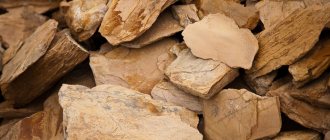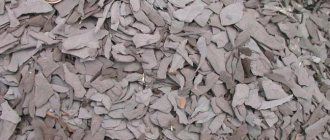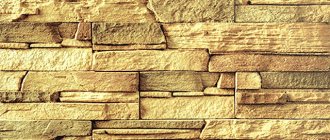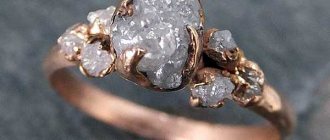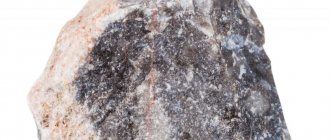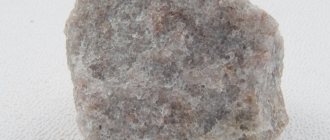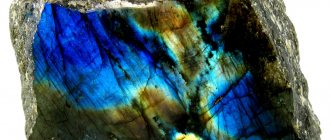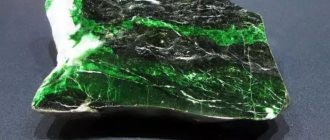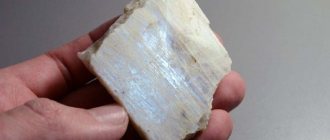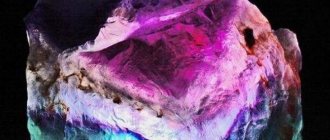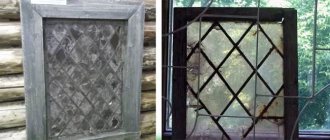Among the huge number of newfangled finishing materials, natural stone has always occupied the leading position in popularity. It is valued for its reliability, durability, presentability and ability to emphasize the wealth and refined taste of the owner. Natural materials come in many varieties, but the most popular is slate stone. In this article we will look at what types it comes in, what its advantages and features are, and what properties it has.
Oil shale
Oil shale (OS) - pyrobituminous shale - sedimentary rocks of carbonate-clayey (marly), clayey or siliceous composition, containing 10-50%, rarely up to 60%, syngenetic sedimentation of organic matter kerogen.
GS have a brown, brown-yellow, gray, olive-gray color, leafy or massive texture.
Shale strata are rocks consisting of clayey limestones and silica, which are saturated with organic matter (OM). These are the main oil source rocks in almost all oil and gas basins of the world. The term "Oil shale" is sometimes used to designate all high-ash solid caustobioliths containing organic substances of various origins and various transformation conditions (carbonaceous, bituminous and liptobiolite shales). Kerogen-syngenetic organic substance with sedimentation with a high yield of resins during dry distillation, with a limited yield of bitumen, extracted with organic solvents at low temperatures. It is rich in hydrogen and its content is closer to oil than to coal. Geologically, kerogen is proto-oil; its content in oil shale ranges from 10% to 60-80%. The starting material for the organic matter of oil shale was the biomass of predominantly lower algae (sapropelic components), to a lesser extent higher plants (humus components) and partly animal organisms. According to the ratio of sapropel and humus components, HSs are divided into: sapropelites (HSs of the Baltic shale basin, Volga basin and Boltysh deposit),
saprohumites (menilite schists of the Carpathians). A distinctive genetic feature of the organic matter of most hydrocarbons is its accumulation in bottom sediments under normal oxygen conditions. The organic matter of HS is characterized by a high hydrogen content (7-10%), a high yield of volatiles during thermal processing (up to 90%), and a high specific heat of combustion (Qbdaf = 29-37 MJ/kg). The main mineral components of the GS are calcite, quartz and clay minerals; feldspars, pyrite, and accessory minerals are of subordinate importance.
Variety of slate types
According to the main classification, shales are divided into clayey and crystalline.
Clay rocks are most often dark gray or green in color. The compressed clay contains inclusions of quartz, sulfur pyrite, lime spar, mica, rutile and many other minerals.
There are separate groups that are formed according to criteria such as structure, composition and physical properties:
- Gray roofing and black slate (or black mountain slate). They are easily separated into plates and are widely used in various technical fields.
- Slate slate is quite soft and is divided into oblong columns. The color of the slate slates is grey.
- The greenish grinding variety is distinguished by its high hardness and high silica content.
- The soft black drawing mineral contains a lot of carbonaceous matter. And the alum variety is also rich in sulfur pyrites.
Crystalline schists have a denser structure and, due to the presence of dark-colored minerals, have a corresponding color.
Sometimes inclusions of quartz or feldspar are found in the composition, which explains the presence of light stripes. Sometimes completely white slate is also found.
What is oil shale?
Oil shale is a type of sedimentary rock that can be used to extract oil, the difficulty of extracting it has historically made it unconventional for the oil and gas industry.
Despite the similarity of names, shale is different from "shale oil". The latter refers to pockets of gas or liquid oil that occur in shale formations such as the Bakken Formation, which extends between North Dakota, Montana, Saskatchewan and Manitoba.
Shale oil – oil of 2 types (according to the classification accepted in the USA):
- Shale oil is a highly viscous shale resin that is significantly different in density and viscosity from traditional oil. Obtained from oil shale after thermal exposure;
- Tight oil - light oil contained in dense, low-porosity and low-permeability reservoirs
The search for shale oil requires new technologies because hydrocarbons are present without a visible seal, are not confined to uplift and without the classic gas-oil-water contact.
Light oil
Light oil (also known as shale oil, shale oil or low-permeability light oil) is light crude oil found in ultra-low permeability oil-bearing formations, often shales or tight sands, but with high oil saturation.
Commercial production from tight oil reservoirs requires the same hydraulic fracturing (fracturing) and often uses the same horizontal well technology as shale gas production.
Although shale oil is sometimes called "shale oil", recently oil shale and shale hydrocarbons have been distinguished
Oil shale is a rock saturated with kerogen, a precursor to oil.
The International Energy Agency (IEA) now recommends using the term “light tight oil” for oil produced from shale or other formations with very low permeability.
Previously, a 2013 World Energy Council report used the terms “tight oil” and “shale rocks.”
Oil and gas bearing shale formations are heterogeneous and vary greatly even over relatively short distances.
Low-permeability reservoirs after hydraulic fracturing can be divided into 4 groups:
- have low matrix porosity and permeability, resulting in cracks dominating both the storage vessel and fluid flow paths;
- have low matrix porosity and permeability, but the matrix provides capacity while the fractures provide fluid flow paths.
- have reservoir microporosity with high matrix porosity but low matrix permeability, which ensures the predominance of induced fractures in fluid paths;
- have macroporous reservoirs with high matrix porosity and permeability, which provides both capacity and flow paths, and fractures only increase permeability.
Due to the variability of well production, it is difficult to evaluate the results and make decisions regarding the profitability of wells. Producing oil from tight reservoirs requires at least 20% natural gas in the reservoir pore space to drive the oil to the wellbore. Hard-to-recover reserves in a reservoir containing only oil may not be economic to extract. Formations that form in marine environments contain less clay and are more brittle, and are therefore more suitable for hydraulic fracturing than formations formed in fresh water, which may contain more clay. Formations with more quartz and carbonate are more fragile.
According to various estimates, the reserves of oil shale and shale oil in the world are estimated at 650 trillion tons, which contain 550–630 billion tons of shale resin (artificial oil), which is even more than the proven reserves of natural oil.
Main characteristics of slate
Natural slates are composed of different minerals. The rock was formed under high pressure and exposure to different temperatures.
The advantage of the breed is:
- Resistant to moisture.
- Fire resistance.
- Immunity to natural factors.
Their formation occurred several million years ago during the period of movement of tectonic plates, volcanic eruptions and geysers. The slates are based on dark-colored stones with particles of silicon and feldspar. Some rocks contain mica.
Types and colors of slate
There are many varieties of slate, differing in color, mineral composition, structure and origin. The color of shale is varied, depending on the presence and amount of minerals and impurities of chemical elements.
The most common are black and gray shales. Black stone (slate, graphite, carbonaceous) has a pronounced graphite tint with a matte sheen; in deposits it is formed in the form of smooth, easily chipped plates.
Gray stones have a beautiful oily sheen, which is why they are in demand in finishing works. In nature, there are also slates of brown, green, yellow, beige, gray, gray-violet, red and white shades.
Based on their chemical composition and mineralogical origin, they are distinguished:
- Shale is a hard rock that is dark gray to black in color. There are examples of green and red shades. The composition contains microscopic particles of clay rocks such as chlorite and hydromica, and is not destroyed in water.
- Siliceous shale is a rock that forms dense thin sheets or slabs of finely crystalline quartz formations with the possible presence of chalcedony. Depending on the amount of impurities, it can be black, gray, red, green or gray-violet.
- Mica schist is a common rock of metamorphic origin with a crystalline structure, which is dominated by quartz and mica.
- Oil shale is a mineral that looks like petrified clay, is easily flammable, has an average density and color varying in yellow and gray tones, often reaching black.
- Chlorite slate is a green stone with a bright shine, the basis of which is chlorite.
Deposits in Russia and the world
The largest shale deposits in the world are located:
- Mongolia;
- countries of Central Asia;
- China;
- Canada;
- USA;
- Brazil;
- Kazakhstan;
- central Europe;
- Republic of Belarus;
- Estonia;
- Ukraine.
On the territory of the CIS countries, the largest deposits are the Volzhskoye, Pribaltiyskoye, Kenderlykskoye (Kazakhstan), and the Arctic.
The main deposits in Russia where mineral extraction takes place:
- Siberia;
- Ural (Ekaterinburg);
- Leningrad region;
- Kirov region;
- Kostroma region;
- Komi Republic;
- Chuvashia;
- North Caucasus.
Mineral deposits
Shale deposits are being developed on almost all continents. They are mined in the USA (Colorado, Wyoming and Utah) and Brazil, in Central Europe and Mongolia. There are shale deposits in Belarus, Ukraine, Kazakhstan, Estonia and the countries of Central Asia.
In Russia, significant volumes of shale rocks are mined in Siberia, the Urals, the Leningrad, Kostroma and Kirov regions, the vicinity of Yekaterinburg, as well as in the territories of Chuvashia, Mordovia, the Komi Republic and the North Caucasus.
Where and how is the rock mined?
Shale deposits are found in different countries. The most common types of shales are clayey and crystalline. Deposits are being developed in a number of Asian countries, the USA, Brazil, Central Europe, Belarus, and Estonia. In Russia, slate stone is mined:
- in the Urals;
- in Siberia;
- Leningrad, Kirov, Kostroma regions;
- near Yekaterinburg;
- in Mordovia, Chuvashia, and the North Caucasus.
Chlorite shales are the least common variety. However, one of the largest deposits of this rock was discovered near the Ural Mountains. There are also deposits of these minerals in other countries:
- in Austria;
- on the Australian mainland;
- on the British islands;
- in Turkey;
- on the island of Madagascar;
- in South Africa;
- on the American continent;
- in China.
Large-scale oil shale development is underway in Canada and the United States. Rock is mined using two methods:
- Open or career. At the location of the mineral deposit, the upper layers of the earth are removed. After the stone monolith is opened, trenching begins. Lumps of material are broken off using special tools and loaded onto vehicles. As rock is removed, quarries of varying depths are formed. This is the most environmentally friendly mining method.
- Underground. Most often used to extract oil shale and shale gas. The method involves drilling deep wells using expensive and complex equipment, and is therefore very expensive. Underground mining carries a high risk of environmental pollution. This method can only be used in areas remote from populated areas, forests and water resources.
Physical properties and deposits of stone
Slate is a popular type of rock that is highly durable and resistant to sudden temperature changes. The stone is waterproof and fireproof. Under the influence of the environment, it can turn into crystalline slate, which easily splits into plates.
Observations of minerals began in the 19th century in Buryatia. While studying the characteristics of minerals, Prince Kropotkin noted the wide variety of shale ores. In the Tunka Basin, where there was previously a deep lake, eroded rocks were discovered. This fact made it possible to establish the influence of environmental conditions on the formation of valuable minerals.
The United States is one of the leaders in shale ore production. Countries such as Russia, China and Poland are not far behind. Since 2012, the term “shale revolution” was introduced. This designation indicates the active introduction of shale rocks into industry and the efficient use of natural gas. Slate dishes are famous for their beauty and affordable price.
Slate is waterproof and fire-resistant
Types of slate
Shales vary in composition and are divided into the following types:
- crystalline schists - the composition is dominated by mica and quartz, often of a gray tint, this also includes biotite schist with a predominance of black mica-biotite, they have medium hardness, low thermal conductivity and high heat resistance;
- siliceous rock - consists of dense plates with chalcedony and quartz grains. Depending on the impurities it has different colors. Solid in density, with a low level of moisture absorption, not sensitive to temperature changes;
- oil shale - the name speaks for itself, is highly flammable, has average density, looks like hardened clay, and when burned, produces a pungent odor and soot;
- clay shale is a dark-colored mineral, hard, resistant to high temperatures, insoluble in water, with inclusions of clay particles, chlorite and hydromica, emits a clayey odor when wet;
- chlorite slate - due to the chlorite content, the stone has a green color with a shiny surface, brittle, non-flammable, with a high ability to absorb sounds;
- slate slate is a soft mineral of a gray hue, easily layered into columns;
- artificial slate.
Kinds
This material has several varieties that differ in composition and origin, but are called by a common name - slate. The stone, photos of which allow you to admire its beauty, is divided into the following groups:
• Clay materials. These include hard rocks from dark gray to black. Occasionally you can find specimens in red and green tones. Blocks are very easily split into tiny particles, which is why they are actively used in the manufacture of finishing materials.
• Siliceous flagstone. This granular rock forms as thin slabs or sheets of crystalline quartz formations. Minerals, depending on the environment of origin and the amount of impurities, can be gray, green, red, purple and black. Sometimes this type of slate stone is used instead of flint.
• Mica flagstone. It is composed of quartz mica and is found in white, brown and black colors.
• Oil shale. This group includes stones that are very similar in appearance to a petrified block of clay. A feature of this type is its rapid flammability. Found in gray and yellow tones.
• Chlorite materials. This includes green slate, which is characterized by iridescence and bright shine. Its basis is chlorite.
Types of slate and their properties
The name “slate” combines many natural stones of different composition and properties, which can be divided into thinner layers. They are divided into groups depending on their composition and general characteristics. Each variety also has several subspecies.
The table provides a brief description of the different shale rocks:
| Group | General characteristics | Characteristic properties | Varieties and their descriptions |
| Clayey | Formed from mineral deposits with various impurities. They can be based on: sericite, quartz, chlorite. Color – black, brown, greyish, green, red. |
|
|
| Crystalline | Stones formed from mica and quartz. Most often they have gray shades. |
|
|
| Siliceous | They are formed from quartz or chalcedony with clay admixtures. The color depends on the amount and characteristics of impurities. There are red, green, purple, black and gray shales. |
|
|
| Chlorite | The basis of the rock is chlorite. The stones are green in color, shimmer, and have a shine. |
|
|
| Flammable | In appearance they look like frozen clay. The color of the rock is yellow, gray and dark gray. |
| They can be divided according to the principle of territorial location and the impurities included in them. |
White
White slate or “alpine” is a rock consisting of layers of plate-like minerals. The composition is dominated by gypsum, so the decorative stone is endowed with such qualities as:
- thermal insulation;
- durability;
- ease;
- strength.
It is resistant to sudden temperature changes, although it is fragile due to its layering. You need to work with it very carefully.
From plaster
Artificial slate made from gypsum has one significant drawback: it can only be used in dry rooms. Gypsum cannot withstand high humidity, as it quickly absorbs moisture and swells.
Advantages:
- ease;
- strength;
- heat capacity.
Important: You can make gypsum tiles yourself by choosing suitable molds for production. Read about pouring decorative stone with your own hands here.
weathered
Weathered is an artificially created material , its texture is very similar to a natural mineral due to its relief chipped surface.
Advantages:
- low price;
- light weight - installation is faster and easier;
- resistance to physical and chemical influences;
- ease of processing - does not crumble, does not delaminate;
- variety of colors and textures.
Classical
Classic material - not too embossed, moderately porous, not bulky. It can be used in any interior. Most often it is used for cladding a large room.
If you need to cover an entire wall, then classic slate with its fine texture is ideal for such a design solution.
Advice: A surface lined with such material will harmonize well with a flat, smoothly painted wall, which will emphasize the beauty and simplicity of the stone.
Large
Decorative slate with a pronounced texture in the interior looks impressive and unusual. Large relief and large differences create a spectacular design. This stone is made from gypsum (for interior work) or cement.
Thin layer
Sheet shale is a rock that has been fractured into thin sheets. They are stacked one on top of the other, with the end of each element visible on the decorative surface. In contrast to the sizes and proportions of other types of elements, the thin-layer material is small in size, with a more pronounced relief and sharp corners.
Description and properties of slate stone
The magical properties of the tiger eye stone
Tiger's eye is a type of quartz with an admixture of fibrous material. It is due to these fibers that the tiger's eye has its characteristic wave-like tint.
Read more
All shales can be classified into two large independent groups - crystalline and clayey. Shale is a hard rock. Essentially, it is clay modified under high pressure. Typically, this slate is black, dark gray or reddish in color. Clay rocks with a greenish tint are rare.
In a homogeneous mass under a microscope, quartz grains, mica leaves and other natural materials can be found in the composition of such a stone. According to their physical properties and structure, clay shales are divided into roofing and slate, grinding (rich in silica), slate and drawing (rich in carbonaceous substances).
Application
Most often, slates are used as roofing material.
, as well as for cladding facades, stairs and fireplaces.
Slate tiles make very beautiful floors. for bathroom flooring
is considered especially relevant due to its moisture resistance.
Often this stone is in demand for paving paths
in the garden, because it is not at all afraid of direct exposure to sunlight and precipitation.
As for crystalline schists, they are metamorphosed rocks that have a holocrystalline structure. Typically, such shales are composed of dark-colored and feldspars, as well as quartz.
Properties
This rock is an excellent fire-resistant material. Thanks to such properties as good heat and sound insulation, water resistance, frost resistance
, slate is also actively used in construction. The main oil shale deposits are located in Russia and the United States.
Some lithotherapists argue that the use of slate in construction is associated not only with its above-mentioned properties. Experts are confident that this stone has impressive healing properties.
– relieves stress and nervous tension, has a beneficial effect on people’s mental state, and helps get rid of chronic insomnia. Shales are suitable for these purposes for almost all zodiac signs, except Capricorns and Aries.
Slate is also believed to have magical properties.
Creative individuals especially like to use it as an amulet. It is believed that he is able to inspire some new ideas and images. Psychics often make special talismans from slate. People with unconventional abilities claim that it is this stone that “connects” them with the Universe and helps expand their consciousness. Some believe that slate, wrapped in purple cloth and placed under a pillow, brings about prophetic dreams.
Artificial
Artificial decorative stone imitation slate differs from natural stone in the following parameters:
- Weight. The lighter the cladding, the easier it is to install. Even a beginner can lay out a wall or some kind of pattern with artificial stone, but to work with natural material, you will most likely have to turn to a professional craftsman.
- Affordable price of an artificial analogue.
Fragments imitating shale rock are produced:
- Made from cement. Cement-based finishing material is universal. Cement has a low price, and products made from it are strong and durable. To make cement fragments, you need a cement mortar and a polyurethane mold that replicates the slate surface.
- Made from plaster. Decorative gypsum material is made from pure G5 grade gypsum, slaked lime, and dye. To make elongated, oblong elements, you will need to purchase a special mold.
For beginners who do not want to deal with mixing cement or gypsum mortar, ready-made dry mix “Kamnedel” is produced.
Read about the production and use of decorative stone from gypsum here, and find out how to make decorative stone at home here.
Medicinal properties
Slate has a positive effect on the emotional background and nervous system. It calms, relieves nervous tension, and helps in the fight against prolonged depression. Therefore, stone is used in the decoration of residential premises, and decorative elements are installed in the bedroom to normalize sleep.
Due to its low thermal conductivity, slate is used in application procedures, for which heated stones are applied to problem organs and joints. The components of shale rocks neutralize chlorine and heavy metal impurities, so water infused on stone is good for health.
Application of slate stone
Slate building stone
Natural slate has long been actively used as a finishing material in the construction of buildings, in landscape design, and for the interior decoration of houses. For example, siltstone shale, the development of which began in the 19th century, was used in the construction of St. Isaac's Cathedral in St. Petersburg. Siltstone plates have a unique color (beige-burgundy, sometimes pink) and an interesting texture.
Crystalline varieties of the rock perform well as a building material. They withstand low temperatures and withstand exposure to ultraviolet rays. This material is very strong and will last a very long time. In addition, it has high sound insulation and excellent heat retention in the room.
Oil shale is used not only as fuel, but also as a raw material for the chemical industry. It is distinguished by its low density and a variety of color options (from gray-yellow to black). However, the active use of this material is hampered by a rather expensive extraction process, attempts to improve which do not stop.
Healing and magical properties of the stone: Slate
Slate
general description
Shales are rocks characterized by an almost parallel arrangement of elongated or plate-like minerals included in their composition and have the ability to split into thin plates.
There are two large groups of shales: clay shales and crystalline shales. Shales are used as cladding, roofing and slate materials. Crystalline shales are used as a building material and as a fire-resistant raw material.
Slate is a volcanic material that comes in a wide range of colors. It comes in yellow, brown, red, burgundy, grey, green, black and shades in between.
Main deposits: Russia, Europe, USA, etc.
Medicinal properties
Lithotherapists argue that the use of slates as a building material is associated not only with the availability of the stone and ease of processing, but also with the fact that it has a positive effect on the human body as a whole. Human dwellings, in the construction of which slate is used, become a real health resort for residents: the stone relieves stress and nervous tension, has a beneficial effect on the psycho-emotional state of people, helps to get rid of insomnia, and treats many nervous disorders.
Magic properties
Astrologers claim that slate connects its owner with the Cosmos. It accumulates signals sent to us from the Universe and transmits them to its owner. To correctly decipher these clues from higher powers, you need to tune in to the slate. Experts suggest doing this as follows: at midnight of the full moon, place a piece of stone in front of you, light two candles and stare at the stone for 15-20 minutes. You will begin to have mental images (figures of people, animals, images of plants, etc.). Ask the slate to interpret these visions. Of course, the stone will not speak human language - it will send you a dream, from which it will be clear that higher powers told you. To have such a dream, the slate must be wrapped in a purple silk rag and placed at the head of the head or under the pillow. This procedure can only be performed during the full moon. On other days it will not give any results. If you did not achieve the desired effect the first time, do not despair - repeat the manipulations on the next full moon.
Slate suits all zodiac signs, excluding Aries and Capricorn. He most readily responds to the requests of Pisces and Cancers.
Talismans and amulets
Slate is a talisman of creative people: writers, artists, musicians.
It awakens creative impulses in them, evokes new images and ideas. However, it will not be possible to become famous and achieve success with its help. It can also be used by people with unconventional abilities - psychics, clairvoyants, fortune-tellers. Slate will help them expand their consciousness, directly connect them with the Cosmos, and teach them to understand the language of the Universe. Share link with friends
Where is it used?
Slates are in demand by industry, decorators, and stone cutters. The scope of application is determined by the characteristics of the raw materials.
Industry
Oil shale is a source of hydrocarbons and raw material for the chemical industry. They are easy to distinguish by their gray-yellow to black shades and low density.
Natural crystalline slate is used as a building material that requires minimal processing.
The stone is valued for many properties:
- Reliability. Walls and roofs made of slate can last for decades. If the installation technology is followed, the roof will not leak or crawl. The mineral is indifferent to natural disasters, temperature changes, heat, cold, and corrosion.
- Houses made of fire-resistant slate are completely fireproof.
- Aesthetics. Slate coating does not “shed” from rain or sun.
Slate (especially crystalline) retains heat, which is of particular importance in regions with harsh climates. And the stone muffles noise just as well.
Decor
Designers love stone for its variety of shades, textures, and texture.
Artificial slate
Decorative stone slate becomes a tabletop in the interior, cladding walls, floors, fireplaces, stoves, and large architectural forms. It looks noble and is beneficial because it retains warmth and privacy.
Slate in the interior
In landscape design these are paths, paths, alpine slides, garden and house compositions.
Other areas
Dishes and items with esoteric themes are made from slate.
And also pendants, bracelets, beads. This decoration is suitable for youth, ethnic, boho and similar clothing styles. You can minimally care for the stone.
The healing properties of slate
In addition to its qualities, which are used in various fields of industry and construction, slate also has some healing properties.
It has long been noticed that if you are in a room decorated with this material, your nervous system calms down, your well-being improves, and stress is relieved.
If you heat a piece of such a stone and apply it to a sore spot, the unpleasant symptoms will go away. In addition, it is useful to drink water infused with it.
Properties of slate
If you are looking for a spectacular, durable, practical and safe finishing material, choose slate. The stone, whose properties allow it to be used in absolutely all areas of construction, is endowed with the following qualities:
• environmental friendliness;
• high strength;
• low degree of water absorption;
• resistance to temperature fluctuations;
• excellent sound and heat insulation abilities;
• no deformation or loss of color under the influence of external factors;
• frost resistance;
• hardness;
• hygiene;
• ease of processing and installation;
• durability.
Understanding Oil Shale
To extract and process oil shale, sedimentary rocks must first be removed using surface or underground mining. These raw materials must then be sent to various processing plants to extract the kerogen contents. During the extraction process, some of these raw materials may have low levels of kerogen deposits.
Some processing methods, known as "ex situ processing", involve mining a deposit of kerogen and then transporting it to a separate facility for processing. Other methods, such as "in-situ processing", involve extracting kerogen from the mine itself.
The United States contains the largest oil shale deposits in the world, most of which are located between Colorado, Utah and Wyoming in the so-called Green River Formation. Other active oil shale producers include the United States, Russia, Germany and China. Historically, Estonia has also been a major producer of oil shale due to the country's large reserves. Despite the abundance of oil shale in the United States, the costs associated with extracting kerogen from rocks make the process generally an environmental concern.
Oil shale is typically used in situations where the price of conventional crude oil becomes prohibitive—often as a result of temporary supply disruptions or geopolitical issues.
Sources
- https://neftegaz.ru/tech-library/energoresursy-toplivo/141700-goryuchie-slantsy-slantsevaya-neft/
- https://nesrakonk.ru/shale/
- https://altenergiya.ru/poleznaya-informaciya/kak-obrazuyutsya-i-primenyayutsya-goryuchie-slancy-osnovnye-mestorozhdeniya-v-mire-i-rossii.html
- https://MoyKamen.com/vidy/prochie/slanec-kamen-chto-eto.html
- https://okcomfort.com/steny/decorativnii-kamen/slanec.html
- https://Karatto.ru/podelochnye-kamni/slanets.html
- https://jgems.ru/podelochnye/slanets
